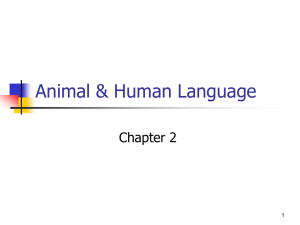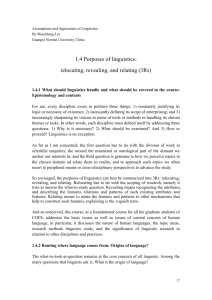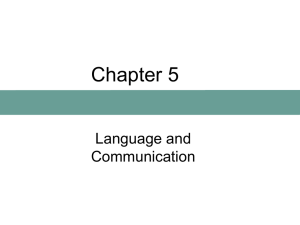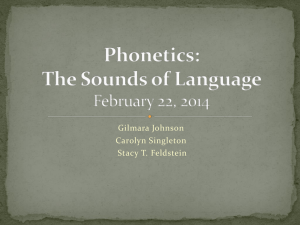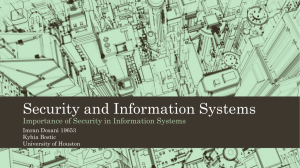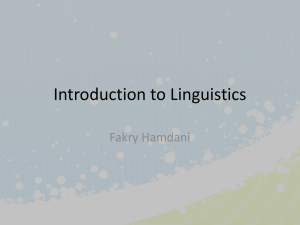Chapter one Invitations to Linguistics
advertisement
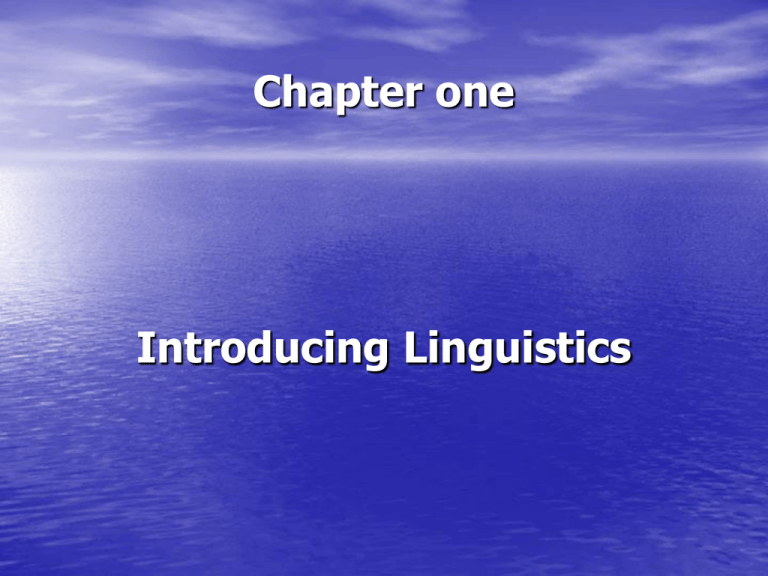
Chapter one Introducing Linguistics What is Language ? A definition: Language is human speech; the ability to communicate by this means; a system of vocal sounds and combinations of such sounds to which meaning is attributed, used for the expression or communication of thoughts and feelings; the written representation of such a system. (Webster's New World Dictionary) Language is many things indeed • A medium of communication • A system of code • A carrier of culture • An instrument for thinking • A glue of a community • A social institution Language is defined as: A systm of arbitrary vocal symbols used for human communication Language is Symbolic People use signs to communicate. The working of signs is called by Saussure "semiology", by Pierce "semiotics“. Signs ---ubiquitous in human society. the location of language in sign systems and the relationship between an object and the sign that stands for the object. Language is Arbitrary A. No logical connection between meaning and sounds. e.g. dog to denote the animal dog, pig ,animal pig e.g. skin not skni has nothing to do with the nature of skin B. Implied meaning of Arbitrary sign = a concept and a sound image combined sign= a signified and a sinifier a. The speaker of a language does not have the power to change a sign in any way once it has become established in the language community. b. Arbitrary = the result of the need to express a wide range of meanings speakers associate linguistic signs with things and concepts, based on the convention established in the community. Language is Primarily Vocal All language use sounds. Writing is based on speaking, to capture sounds and meanings on paper. The primary medium of language is sound. Why? Five reasons: 1. Children learn to speak before they learn to read and write. 2. Children automatically learn a language as they grow up.18 months -12 yrs : sufficient exposure to writing: not natural, needs teachers 3. The spoken form came earlier than written form in history. 4. writing is based on speech. 5. Spoken language is used more often than writing. Implied Meaning : 1. Writing extends language beyond the limitations of time and space. 2. Written language is more polished than speech, great differences; e.g. classical Latin & language used in Roman Empire. Language is Human Specific Human language is different from animal communications in the following aspects. 1. the ability to refer to things far removed in time and space= displacement of lge 2. the ability to produce the understand an indefinite number of novel sentences.=creativity of lge 3. learning -a more important factor in human language than in animal communication. 4. Language is complex in its structure. 5. Animal communication system is closed, whereas human lge is open 6. Humans can perform acts with lge.= performative function of lge Language is used for Communication We use more words than we use gestures when we communicate with others. Why is so? Just reflect on what we have discussed above. Features of human Language 1. Creativity/productivity 2. Duality 3. Arbitrariness 4. Displacement 5. Cultural transmission 6. Interchangeability 7. Reflexivity People can learn and use a language. Two basic systems: a system of sounds ; a system of meanings. It's called the duality of language. Concern: features of the two systems and their relationship. Creativity is the first and foremost striking feature of human language. It refers to the fact that language provides opportunities for sending messages that have never been sent before and for understanding novel messages. The grammar rules and the words are finite, but the sentences are infinite. Every speaker uses language creatively. Duality • Language contains two subsystems, one of sounds and • • • • the other of meanings. People can learn and use a language. Two basic systems: a system of sounds ; a system of meanings. It's called the duality of language. Certain sounds or sequences of sounds stand for certain meanings. Certain meanings are conveyed by certain speech sounds or sequences of speech sounds. Concern: features of the two systems and their relationship. Arbitrariness • The relationship between the two subsystems of language is arbitrary. • There is no logical connection between sound and meaning. Displacement • There is no limit in time or space for language. • Language can be used to refer to things real or imagined, past, present or future. Cultural transmission • Culture cannot be genetically transmitted. Instead, it must be learned. • Language is a way of transmitting culture. • Language is the carrier of culture. Interchangeability All members of a speech community can send and receive messages. Reflexivity • Human languages can be used to describe themselves. • The language used to talk about language is called meta-language. The functions of language: three meta-functions The ideational function To identify things, to think, or to record information. The interpersonal function To get along in a community. The textual function To form a text. Types of language • Natural languages and artifical languages A natural language is one that is the mother tongue of an ethnic community. Natural languages that are used to break the barrier of communication between nations are called world lingua francas. An artifical languages is an invented one. Esperanto was created by a Polish oculist Genetic classification The Indo-European family is one of the largest families. English belongs to the West Germanic division. Chinese belongs to the Sino-Tibetan family. Typological classification • Analytic language – no inflections or formal changes, • • grammatical relationships are shown through word order, such as Chinese and Vietnamese Synthetic language – grammatical relationships are expressed by changing the internal structure of the words, typically by changing the inflectional endings, such as English and German Agglutinating language – words are built out of a long sequence of units, with each unit expressing a particular grammatical meaning, such as Japanese and Turkish The myth of language – language origin • The Biblical account • • • • Language was God’s gift to human beings. The bow-wow theory Language was an imitation of natural sounds, such as the cries of animals, like quack, cuckoo. The pooh-pooh theory Language arose from instinctive emotional cries, expressive of pain or joy. The yo-he-ho theory Language arose from the noises made by a group of people engaged in joint labour or effort – lifting a huge hunted game, moving a rock, etc. The evolution theory Language originated in the process of labour and answered the call of social need What is linguistics? • Linguistics is the scientific study of language. The object of study in linguistics is language. • Observing & questioning • Formulating hypotheses • Verifying the hypotheses • Proposing a theory Branches of linguistics Internal branches: intra-disciplinary divisions – Phonetics the production of speech, – Phonology studies the rules governig the structure ,the sequencing of speech sounds and the shape of syllables. – Morphology the internal organization of words, the minimal units of meaning –morphemes and wordformation process. – Syntax principles of forming and undrstanding correct English sentences – Semantics How meaning is encoded in a language – Pragmatics the study of meaning in context. External branches: inter-disciplinary divisions – Psycholinguistics the interrelation of language and mindin processing and producing utterances and in language acquisition – Sociolinguistics the social function of language and the social characteristics of its users. – Anthropological linguistics the history and structure of unwritten languages – Computational languistics the use of computer to process or produce huamn language – Applied linguistics the application of linguistic theories and descriptions in language teaching. Features of Modern linguistics Spoken language rather than written Descriptive and prescriptive Synchronic and diachronic Theoretically rather than pedagogicall oriented

